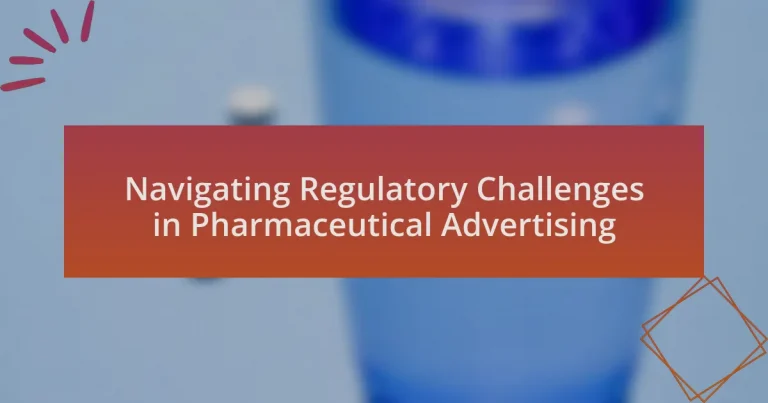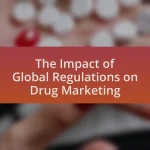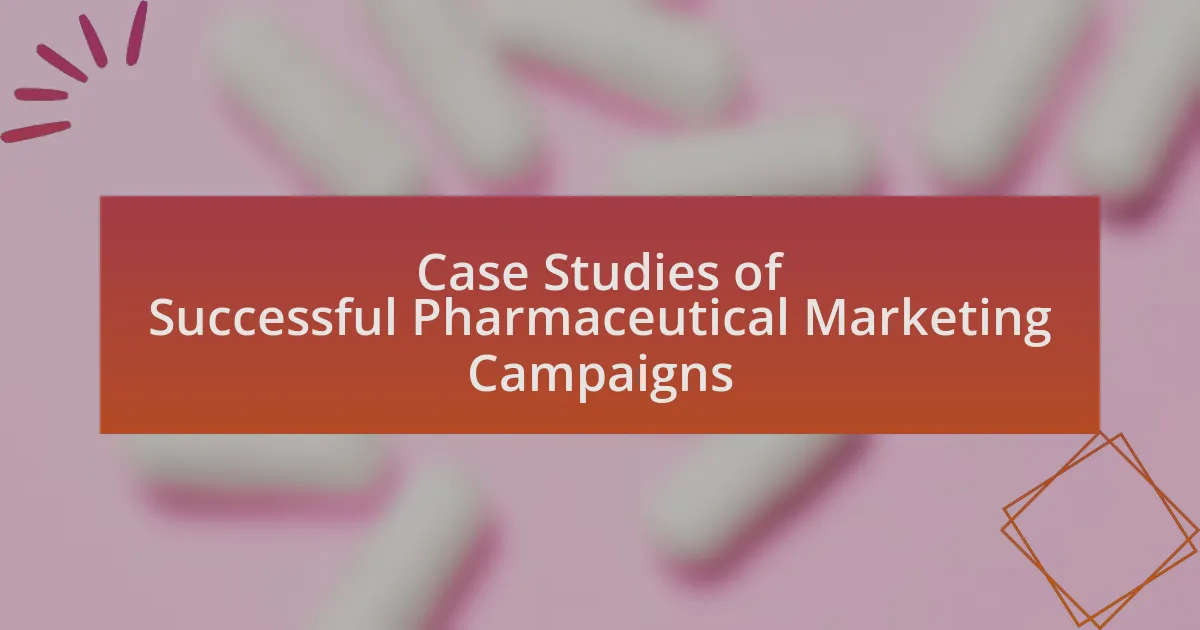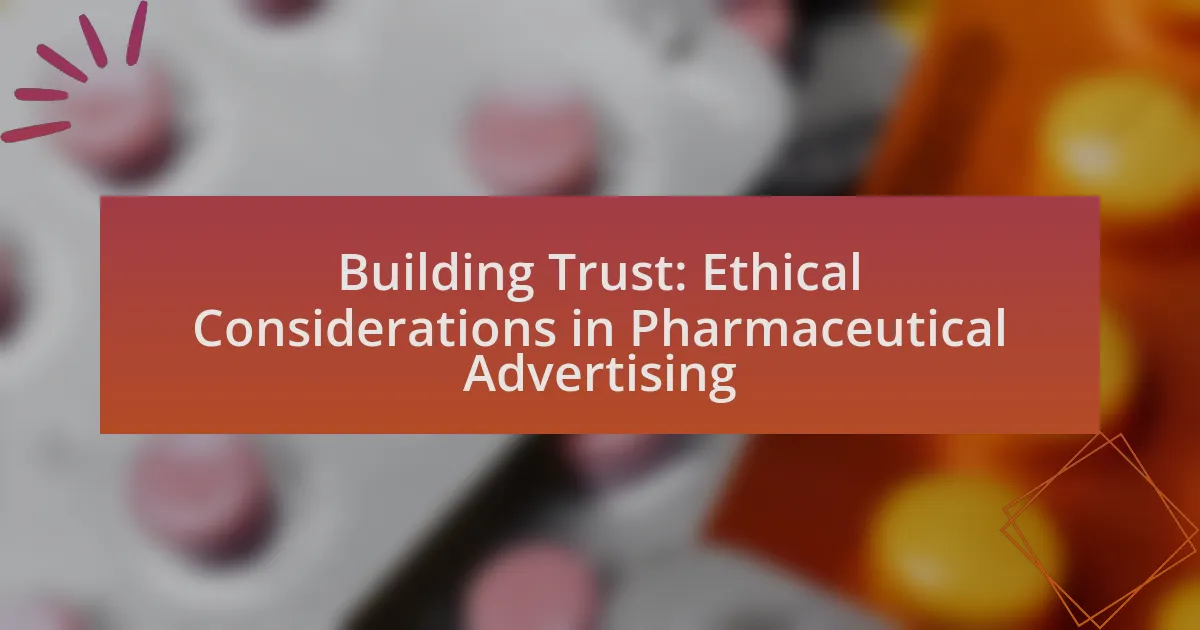The article focuses on the regulatory challenges faced by pharmaceutical companies in advertising their products. It outlines the stringent compliance requirements imposed by regulatory bodies such as the FDA in the United States and highlights the differences in regulations across various regions, including the European Union and Canada. Key topics include the importance of truthful advertising, the consequences of non-compliance, and strategies for maintaining adherence to regulations. Additionally, the article discusses the role of technology and data analytics in compliance management, best practices for ethical advertising, and common pitfalls to avoid in pharmaceutical marketing.
What are the key regulatory challenges in pharmaceutical advertising?

The key regulatory challenges in pharmaceutical advertising include compliance with stringent regulations, ensuring truthful and non-misleading claims, and navigating varying international standards. Regulatory bodies, such as the FDA in the United States, impose strict guidelines that require pharmaceutical companies to provide balanced information about risks and benefits. Non-compliance can lead to significant penalties, as evidenced by the FDA’s enforcement actions against companies for misleading advertisements. Additionally, the global nature of pharmaceutical marketing complicates adherence to diverse regulations across different countries, making it essential for companies to stay informed about local laws and practices.
How do regulations vary across different regions?
Regulations in pharmaceutical advertising vary significantly across different regions due to differing legal frameworks, cultural attitudes, and healthcare systems. For instance, in the United States, the Food and Drug Administration (FDA) regulates pharmaceutical advertising, requiring that advertisements be truthful and not misleading, while also mandating the inclusion of risk information. In contrast, the European Union has stricter regulations, prohibiting direct-to-consumer advertising for prescription medications altogether, as outlined in the EU Directive 2001/83/EC. Additionally, countries like Canada have a hybrid approach, allowing some forms of direct advertising but with stringent guidelines to ensure consumer protection. These variations reflect the unique regulatory environments and public health priorities of each region.
What are the specific regulations in the United States?
The specific regulations in the United States regarding pharmaceutical advertising are primarily governed by the Federal Food, Drug, and Cosmetic Act (FDCA) and enforced by the Food and Drug Administration (FDA). These regulations require that advertisements for prescription drugs must be truthful, not misleading, and provide a fair balance of information about the benefits and risks associated with the drug. Additionally, the regulations mandate that advertisements must include the drug’s approved uses and any relevant safety information, ensuring that consumers receive comprehensive information to make informed decisions. The FDA also monitors promotional materials to ensure compliance, and violations can result in significant penalties.
How do European regulations differ from those in the U.S.?
European regulations on pharmaceutical advertising are generally more stringent than those in the U.S. For instance, the European Union’s Directive 2001/83/EC prohibits direct-to-consumer advertising for prescription medications, while the U.S. allows such advertising under specific guidelines set by the FDA. Additionally, European regulations require a higher level of transparency and disclosure regarding clinical trial data and potential side effects, as mandated by the European Medicines Agency. This contrasts with U.S. regulations, which focus more on the balance of benefits and risks but do not impose the same level of restrictions on advertising practices.
Why is compliance critical for pharmaceutical companies?
Compliance is critical for pharmaceutical companies because it ensures adherence to regulatory standards that safeguard public health and maintain product integrity. Regulatory bodies, such as the FDA, impose strict guidelines on drug development, marketing, and distribution to prevent misinformation and protect consumers. Non-compliance can lead to severe consequences, including hefty fines, product recalls, and damage to reputation. For instance, in 2020, the FDA issued over $1 billion in fines for violations related to pharmaceutical advertising, highlighting the financial risks associated with non-compliance. Thus, maintaining compliance is essential for legal operation, consumer trust, and overall business sustainability in the pharmaceutical industry.
What are the potential consequences of non-compliance?
Non-compliance in pharmaceutical advertising can lead to severe legal and financial repercussions. Companies may face hefty fines, which can reach millions of dollars, as seen in cases where regulatory bodies like the FDA impose penalties for misleading advertisements. Additionally, non-compliance can result in reputational damage, leading to loss of consumer trust and decreased market share. For instance, a study by the American Medical Association highlighted that companies with a history of non-compliance often experience a significant drop in stock prices following regulatory actions. Furthermore, ongoing non-compliance can lead to increased scrutiny from regulators, resulting in more frequent audits and potential restrictions on marketing practices.
How does compliance impact brand reputation?
Compliance significantly impacts brand reputation by establishing trust and credibility with consumers and stakeholders. When a pharmaceutical company adheres to regulatory standards, it demonstrates a commitment to ethical practices and patient safety, which enhances its public image. For instance, a study published in the Journal of Business Ethics found that companies with strong compliance programs experience higher levels of consumer trust and loyalty. Conversely, non-compliance can lead to legal penalties, negative media coverage, and a loss of consumer confidence, ultimately damaging the brand’s reputation.
What strategies can pharmaceutical companies use to navigate these challenges?

Pharmaceutical companies can navigate regulatory challenges in advertising by implementing comprehensive compliance programs, engaging in proactive communication with regulatory bodies, and utilizing data analytics for targeted marketing strategies. Comprehensive compliance programs ensure that all advertising materials adhere to legal standards, reducing the risk of penalties. Proactive communication with regulatory bodies fosters transparency and helps companies stay informed about evolving regulations. Additionally, data analytics allows companies to tailor their advertising efforts to specific audiences while remaining compliant with regulations, as evidenced by the increased effectiveness of targeted campaigns in recent studies.
How can companies stay updated on regulatory changes?
Companies can stay updated on regulatory changes by subscribing to industry newsletters and regulatory agency alerts. These resources provide timely information on new regulations and amendments relevant to pharmaceutical advertising. For instance, organizations like the FDA and EMA regularly publish updates that can be accessed through their official websites. Additionally, participating in industry associations and attending conferences can facilitate networking with peers who share insights on compliance and regulatory trends. This multi-faceted approach ensures that companies remain informed and can adapt their advertising strategies accordingly.
What resources are available for tracking regulatory updates?
Resources available for tracking regulatory updates include government websites, industry associations, and specialized regulatory tracking services. Government websites, such as the U.S. Food and Drug Administration (FDA) and the European Medicines Agency (EMA), provide official updates on regulations and guidelines. Industry associations like the Pharmaceutical Research and Manufacturers of America (PhRMA) and the Biotechnology Innovation Organization (BIO) offer insights and summaries of regulatory changes relevant to pharmaceutical advertising. Additionally, specialized services such as Regulatory Affairs Professionals Society (RAPS) and compliance software platforms provide real-time alerts and comprehensive databases for monitoring regulatory developments. These resources ensure that stakeholders remain informed about the latest regulatory changes impacting pharmaceutical advertising.
How can companies implement effective training programs for staff?
Companies can implement effective training programs for staff by conducting a thorough needs assessment to identify specific skills and knowledge gaps related to regulatory challenges in pharmaceutical advertising. This assessment should involve gathering input from various stakeholders, including compliance officers and marketing teams, to ensure that the training content is relevant and comprehensive.
Once the needs are identified, companies should develop targeted training materials that cover key regulatory requirements, industry standards, and best practices in pharmaceutical advertising. Incorporating real-world case studies and examples can enhance understanding and retention of the material.
Additionally, companies should utilize a mix of training methods, such as workshops, e-learning modules, and interactive sessions, to cater to different learning styles and increase engagement. Regular assessments and feedback mechanisms should be established to evaluate the effectiveness of the training and make necessary adjustments.
Research indicates that organizations with structured training programs see a 37% increase in productivity and a 24% increase in employee satisfaction, highlighting the importance of effective training in achieving organizational goals.
What role does technology play in compliance management?
Technology plays a crucial role in compliance management by automating processes, enhancing data accuracy, and facilitating real-time monitoring of regulatory requirements. Automated systems reduce human error and ensure that compliance tasks are completed efficiently, while advanced data analytics tools help organizations track and analyze compliance-related data effectively. For instance, according to a report by Deloitte, companies that implement compliance technology can reduce compliance costs by up to 30% and improve their ability to respond to regulatory changes swiftly. This integration of technology not only streamlines compliance workflows but also strengthens an organization’s ability to adhere to complex regulations in industries such as pharmaceutical advertising.
How can data analytics improve regulatory compliance?
Data analytics can improve regulatory compliance by enabling organizations to monitor and analyze their advertising practices in real-time, ensuring adherence to regulations. By utilizing advanced analytics tools, companies can identify patterns and anomalies in their advertising data, which helps in detecting potential compliance issues before they escalate. For instance, a study by the Pharmaceutical Research and Manufacturers of America (PhRMA) found that companies employing data analytics reported a 30% reduction in compliance violations due to proactive monitoring and timely adjustments to their advertising strategies. This demonstrates that data analytics not only enhances oversight but also fosters a culture of compliance within organizations.
What tools are available for monitoring advertising practices?
Tools available for monitoring advertising practices include software solutions like AdWatcher, which tracks and analyzes advertising content across various media platforms. These tools provide insights into compliance with regulations, effectiveness of campaigns, and competitor strategies. For instance, AdWatcher offers real-time monitoring and reporting features that help organizations ensure their advertising adheres to industry standards and legal requirements. Additionally, platforms like Moat and Comscore provide analytics on ad performance and viewability, further supporting compliance and effectiveness assessments in advertising practices.
What are the best practices for ethical pharmaceutical advertising?
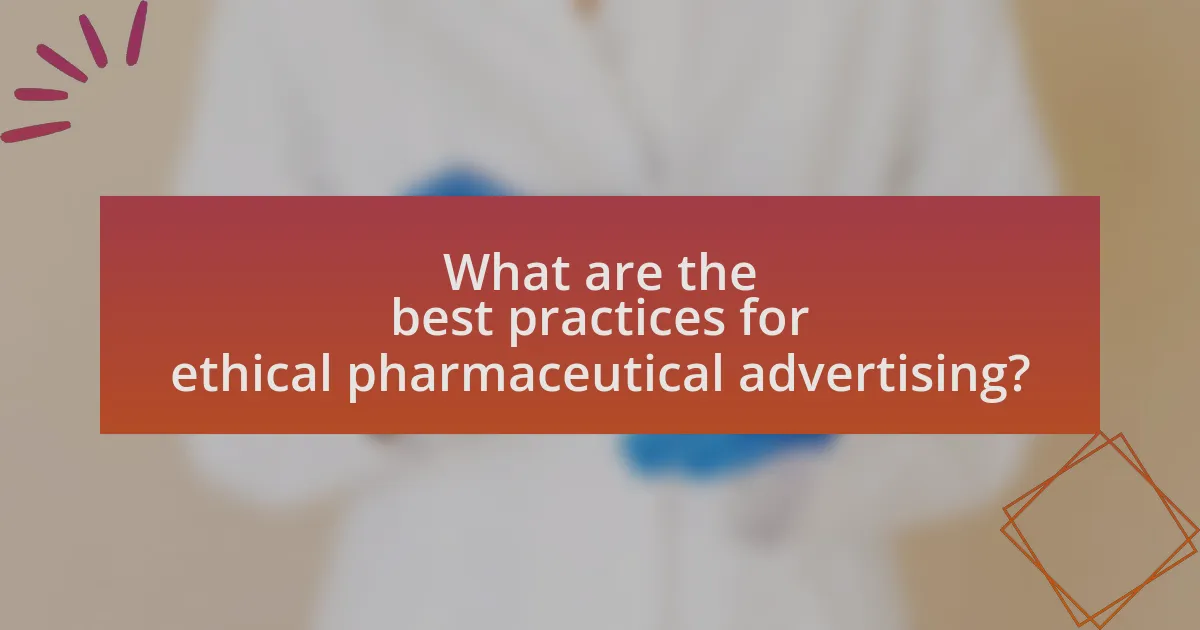
The best practices for ethical pharmaceutical advertising include ensuring transparency, providing balanced information, and adhering to regulatory guidelines. Transparency involves clearly disclosing the risks and benefits of medications, allowing consumers to make informed decisions. Balanced information means presenting both the positive and negative aspects of a drug, which is essential for maintaining trust and credibility. Adhering to regulatory guidelines, such as those set by the FDA in the United States, ensures that advertisements are truthful and not misleading, thereby protecting public health. These practices are supported by the need for ethical standards in healthcare marketing, which aim to prioritize patient welfare and informed consent.
How can companies ensure transparency in their advertising efforts?
Companies can ensure transparency in their advertising efforts by adhering to regulatory guidelines and providing clear, accurate information about their products. This includes disclosing potential side effects, the efficacy of treatments, and any financial relationships with healthcare professionals. For instance, the Pharmaceutical Research and Manufacturers of America (PhRMA) Code emphasizes the importance of truthful communication and full disclosure in pharmaceutical advertising, which helps build trust with consumers and healthcare providers. Additionally, companies can implement internal audits and compliance training to ensure that all advertising materials meet legal standards and ethical practices, thereby reinforcing their commitment to transparency.
What guidelines should be followed for truthful advertising?
Truthful advertising in the pharmaceutical sector should adhere to guidelines that ensure accuracy, clarity, and honesty in messaging. These guidelines include providing clear and substantiated claims about the product’s benefits and risks, avoiding misleading information, and ensuring that all promotional materials are consistent with the product’s approved labeling. For instance, the Federal Trade Commission (FTC) mandates that advertisements must not contain false or deceptive statements, and the Food and Drug Administration (FDA) requires that promotional materials present a balanced view of the drug’s efficacy and side effects. Compliance with these regulations is essential to maintain consumer trust and uphold ethical standards in pharmaceutical advertising.
How can companies balance marketing goals with ethical considerations?
Companies can balance marketing goals with ethical considerations by implementing transparent practices and adhering to regulatory guidelines. For instance, pharmaceutical companies must ensure that their advertising is truthful and not misleading, as mandated by the FDA regulations. This involves providing clear information about drug benefits and risks, which not only aligns with ethical standards but also builds consumer trust. Research indicates that companies that prioritize ethical marketing practices can enhance their brand reputation and customer loyalty, ultimately supporting long-term marketing goals.
What common pitfalls should be avoided in pharmaceutical advertising?
Common pitfalls to avoid in pharmaceutical advertising include misleading claims, lack of balanced information, and failure to disclose risks. Misleading claims can lead to regulatory scrutiny and damage to credibility, as seen in cases where companies faced penalties for overstating drug efficacy. Lack of balanced information, such as not presenting both benefits and risks, can misinform healthcare professionals and patients, violating guidelines set by regulatory bodies like the FDA. Additionally, failure to disclose risks associated with a medication can result in legal consequences and harm to patients, as evidenced by lawsuits against companies that did not adequately inform users of potential side effects.
What are the most frequent mistakes made by companies?
The most frequent mistakes made by companies in pharmaceutical advertising include non-compliance with regulatory guidelines, misleading claims about products, and inadequate risk communication. Non-compliance can lead to significant legal penalties; for instance, the FDA has issued fines totaling millions of dollars for violations in advertising practices. Misleading claims can result in loss of consumer trust and potential lawsuits, as seen in cases where companies exaggerated the efficacy of their drugs. Additionally, inadequate risk communication can lead to patient harm and regulatory scrutiny, emphasizing the importance of clear and accurate information in advertising materials.
How can companies learn from past advertising failures?
Companies can learn from past advertising failures by conducting thorough post-campaign analyses to identify the reasons for failure, such as misalignment with regulatory standards or misinterpretation of target audience needs. For instance, the pharmaceutical industry has faced significant backlash from campaigns that did not comply with FDA regulations, leading to costly penalties and reputational damage. By reviewing these cases, companies can pinpoint specific regulatory missteps, such as inadequate disclosures or misleading claims, and adjust their strategies accordingly. This approach not only helps in avoiding similar pitfalls in future campaigns but also fosters a culture of compliance and ethical advertising practices.
What practical tips can help companies navigate regulatory challenges effectively?
To navigate regulatory challenges effectively, companies should implement a robust compliance program that includes regular training, clear communication channels, and thorough documentation practices. A well-structured compliance program ensures that employees are aware of regulatory requirements and can identify potential issues early. Regular training sessions help keep staff updated on changes in regulations, while clear communication channels facilitate reporting of compliance concerns. Additionally, maintaining thorough documentation provides a reliable record of compliance efforts, which can be crucial during audits or investigations. According to a study by the Compliance and Ethics Institute, organizations with effective compliance programs experience 50% fewer regulatory violations, demonstrating the importance of these practices in mitigating risks.
